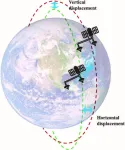(Press-News.org) EMBARGOED UNTIL 15:00 EDT MONDAY, MAY 20, 2024
For the first time, there is visible evidence showing that warm seawater is pumping underneath Antarctica’s Thwaites Glacier—ominously nicknamed the Doomsday Glacier.
An international team of scientists—including a researcher from the University of Waterloo—observed it using satellite imagery and warns that it could accelerate catastrophic sea level rise in 10 to 20 years.
The intrusion of seawater causes the ice to continuously lift off the land and settle back down again. Ice melts intensely when it first touches seawater, and because Thwaites Glacier measures about 120 kilometres wide by 1.2 kilometres deep, this effect could lead to devastating sea level rise. The glacier is situated in a basin. To date, the ocean water has only touched the rim of it. But the researchers predict it may only take 10 to 20 years before the glacier retreats into the deeper part of the basin, at which point glacier melt will likely speed up even more.
“Thwaites is the most unstable place in the Antarctic and contains the equivalent of 60 centimetres of sea level rise,” said Dr. Christine Dow, a professor in the Faculty of Environment at the University of Waterloo, and a co-author of the study. “The worry is that we are underestimating the speed that the glacier is changing, which would be devastating for coastal communities around the world.”
The world has already felt the social and economic consequences from a couple of centimetres of sea level rise. However, the researchers note that the sea level rise of an additional half-metre or more will gravely impact populations in many low-lying areas like Vancouver, Florida, Bangladesh and low-lying Pacific islands, such as Tuvalu and the Marshall Islands.
The researchers used ICEYE DInSAR satellite data and subglacial water modelling to detect the seawater intrusion and its impacts. Dow and her team at Waterloo are currently working on creating new models that consider the impact of ocean water flowing into the basin and subglacial water flowing out and mixing with ocean water to accurately predict how fast the glacier will melt.
“At the moment we don't have enough information to say one way or the other how much time there is before the ocean water intrusion is irreversible,” said Dow, who is also the Canada Research Chair in Glacier Hydrology and Ice Dynamics. “By improving the models and focusing our research on these critical glaciers, we will try to get sea level rise estimates at least pinned down for decades versus centuries. This work will help people adapt to changing ocean levels along with focusing on reducing carbon emissions to prevent the worst-case scenario.”
Dr. Eric Rignot, lead author and professor of Earth system science at the University of California, Irvine (UC Irvine) hopes these results will lead to increased support for research examining the changes taking place beneath glaciers in Antarctica.
“There is a lot of enthusiasm from the scientific community to go to these remote, polar regions to gather data and build our understanding of what’s happening, but the funding is lagging,” said Rignot, who is also affiliated with the Jet Propulsion Laboratory at the California Institute of Technology. “We operate at the same budget in 2024 in real dollars that we were in the 1990s. We need to grow the community of glaciologists and physical oceanographers to address these observation issues sooner rather than later, but right now we’re trying to climb Everest in tennis shoes.”
Dow and Rignot collaborated with researchers at UC Irvine and ICEYE. The study, Widespread seawater intrusions beneath the grounded ice of Thwaites Glacier, West Antarctica, appears in Proceedings of the National Academy of Sciences (PNAS).
END
Warm seawater speeding up melting of ‘Doomsday Glacier,’ scientists warn
Satellite data provides first evidence of ocean water intrusion beneath Antarctica’s Thwaites Glacier
2024-05-20
ELSE PRESS RELEASES FROM THIS DATE:
Can coal mines be tapped for rare earth elements?
2024-05-20
Deposits of designated critical minerals needed to transition the world’s energy systems away from fossil fuels may, ironically enough, be co-located with coal deposits that have been mined to produce the fossil fuel most implicated in climate change.
Now, research led by the University of Utah has documented elevated concentrations of a key subset of critical minerals, known as rare earth elements, or REEs, in active mines rimming the Uinta coal belt of Colorado and Utah.
These findings open the possibility that these mines could see a secondary resource stream in the form of metals used in renewable energy and numerous other high-tech ...
Electric school buses may yield significant health and climate benefits, cost savings
2024-05-20
EMBARGOED FOR RELEASE: MONDAY, MAY 20, 2024, 3:00 PM ET
Key points:
Replacing an average diesel school bus from 2017 with an electric one may result in $84,200 in health and climate benefits—including fewer greenhouse gas emissions and reduced rates of mortality and childhood asthma—per individual bus.
Those benefits may increase to $247,600 per individual electric school bus replacing a diesel bus from 2005 or earlier in a large metropolitan area.
While the benefits of replacing diesel vehicles with electric ones are well known, this is the first study to specifically quantify the health and climate benefits of replacing diesel school buses with electric ...
Aston University experts team up with medical products company to help make endoscopes cleaner and safer
2024-05-20
Endoscopes are instruments that are used to look inside the body
Even with new developments cleaning them sufficiently has been a challenge
The University has entered a knowledge transfer partnership (KTP) with PFE Medical to improve the process by removing bacterial biofilm inside them.
Aston University experts are teaming up with a medical products company to improve the cleaning of endoscopes.
Endoscopes are long, thin instruments with a light and camera at one end that are used to look inside the body.
Cleaning them sufficiently has been a challenge and even with new developments they can ...
New method to reveal what drives brain diseases
2024-05-20
LA JOLLA, CA — The brain is often referred to as a “black box”—one that’s difficult to peer inside and determine what’s happening at any given moment. This is part of the reason why it’s difficult to understand the complex interplay of molecules, cells and genes that underly neurological disorders. But a new CRISPR screen method developed at Scripps Research has the potential to uncover new therapeutic targets and treatments for these conditions.
The method, outlined in a study published in Cell on May 20, 2024, provides a way to rapidly examine the brain cell types ...
AI chips could get a sense of time
2024-05-20
Image
Artificial neural networks may soon be able to process time-dependent information, such as audio and video data, more efficiently. The first memristor with a 'relaxation time' that can be tuned is reported today in Nature Electronics, in a study led by the University of Michigan.
Memristors, electrical components that store information in their electrical resistance, could reduce AI's energy needs by about a factor of 90 compared to today's graphical processing units. Already, AI is projected to account for about half a percent of the world's total electricity ...
PARC model of care associated with fewer deaths among veterans post-ICU
2024-05-20
EMBARGOED UNTIL: 10:15 a.m. PT, Monday, May 20, 2024
PARC MODEL OF CARE ASSOCIATED WITH FEWER DEATHS AMONG VETERANS POST-ICU
Session: B18 – Bridging Gaps to Improve Long-Term Outcomes
The Post-Acute Recovery Center: A Telehealth Care Model to Improve Patient-Centered Outcomes for High-Risk Survivors of Critical Illness
Date and Time: Monday, May 20, 2024, 10:15 a.m. PT
Location: San Diego Convention Center, Room 32A-B (Upper Level)
ATS 2024, San Diego – Research presented at the ATS 2024 International Conference demonstrates that veterans who received ...
Department of Energy announces $6 million for isotope R&D
2024-05-20
WASHINGTON, D.C. - Today, the U.S. Department of Energy (DOE) announced $6 million in funding for 12 awards across eight efforts to advance research in isotope enrichment, targetry, and separations. This funding is part of a key federal program that produces critical isotopes otherwise unavailable or in short supply in the U.S.
Isotopes, or variations of the same elements that have the same number of protons but different numbers of neutrons, have unique properties that make them powerful in medical diagnostic and treatment applications. They are also essential for applications in quantum information science, nuclear power, national security, and more.
“These ...
World leaders still need to wake up to AI risks, say leading experts ahead of AI Safety Summit
2024-05-20
UNDER EMBARGO UNTIL 19:00 BST / 14:00 ET MONDAY 20 MAY 2024.
World leaders still need to wake up to AI risks, say leading experts ahead of AI Safety Summit
More information, including a copy of the paper, can be found online at the Science press package at https://www.eurekalert.org/press/scipak/, or can be requested from scipak@aaas.org
Leading AI scientists are calling for stronger action on AI risks from world leaders, warning that progress has been insufficient since the first AI Safety Summit in Bletchley Park six months ago.
Then, the world’s leaders pledged to govern AI responsibly. However, as the second AI Safety Summit in Seoul ...
*FREE* Managing extreme AI risks amidst rapid technological development
2024-05-20
Although researchers have warned of the extreme risks posed by rapidly developing artificial intelligence (AI) technologies, there is a lack of consensus about how to manage them. In a Policy Forum, Yoshua Bengio and colleagues examine the risks of advancing AI technologies – from the social and economic impacts, malicious uses, and the possible loss of human control over autonomous AI systems – and recommend directions for proactive and adaptive governance to mitigate them. They call on major technology companies and public funders to invest more – at least one-third of their budgets – into assessing and ...
Advancing 3D mapping with tandem dual-antenna SAR interferometry
2024-05-20
The new Tandem Dual-Antenna Spaceborne Synthetic Aperture Radar (SAR) Interferometry (TDA-InSAR) system, addresses the limitations of current spaceborne Synthetic Aperture Radar (SAR) systems by providing a more reliable and efficient method for 3D surface mapping. The system's innovative design allows for single-pass acquisitions, significantly reducing the time required for data collection and enhancing the precision of 3D reconstructions in various terrains, including built-up areas and vegetation canopies.
Synthetic Aperture Radar (SAR) interferometry (InSAR) is a powerful tool for producing high-resolution topographic maps. However, traditional InSAR techniques face ...
LAST 30 PRESS RELEASES:
New science reporting guide published for journalists in Bulgaria
New international study reveals major survival gaps among children with cancer
New science reporting guide published for journalists in Turkey
Scientists develop a smarter mRNA therapy that knows which cells to target
Neuroanatomy-informed brain–machine hybrid intelligence for robust acoustic target detection
Eight SwRI hydrogen projects funded by ENERGYWERX
The Lundquist Institute and its start-up company Vitalex Biosciences Announces Strategic Advancement of Second-Generation fungal Vaccine VXV-01 through Phase 1 Trials under $40 Million Competitive Con
Fine particles in pollution are associated with early signs of autoimmune disease
Review article | Towards a Global Ground-Based Earth Observatory (GGBEO): Leveraging existing systems and networks
Penn and UMich create world’s smallest programmable, autonomous robots
Cleveland researchers launch first major study to address ‘hidden performance killer’ in athletes
To connect across politics, try saying what you oppose
Modulating key interaction prevents virus from entering cells
Project explores barriers to NHS career progression facing international medical graduates
Jeonbuk National University researchers explore the impact of different seasonings on the flavor perception of Doenjang soup
Two Keck Medicine of USC Hospitals named Leapfrog Top Teaching Hospitals
World-first discovery uncovers how glioblastoma tumours dodge chemotherapy, potentially opening the door to new treatments
A fatal mix-up: How certain gut bacteria drive multiple sclerosis
New AI tool identifies not just genetic mutations, but the diseases they may cause
Deep-learning model predicts how fruit flies form, cell by cell
Combination pills for high blood pressure may simplify treatment, improve long-term health
Immune system keeps mucosal fungi in check
Neurons within the brain use simple rules to localize genetic messages
Electrodes created using light
Second-hand gift-giving is a well-deliberated decision
How human interaction drove evolution to make bears less aggressive
National Poll: Few parents offer teens guidance on healthy eating during holiday season
Cannabis derivatives could provide new ovarian cancer treatments
Raising strong yeast as a petroleum substitute
Clues to the origin of hot Jupiters hidden in their orbits
[Press-News.org] Warm seawater speeding up melting of ‘Doomsday Glacier,’ scientists warnSatellite data provides first evidence of ocean water intrusion beneath Antarctica’s Thwaites Glacier



